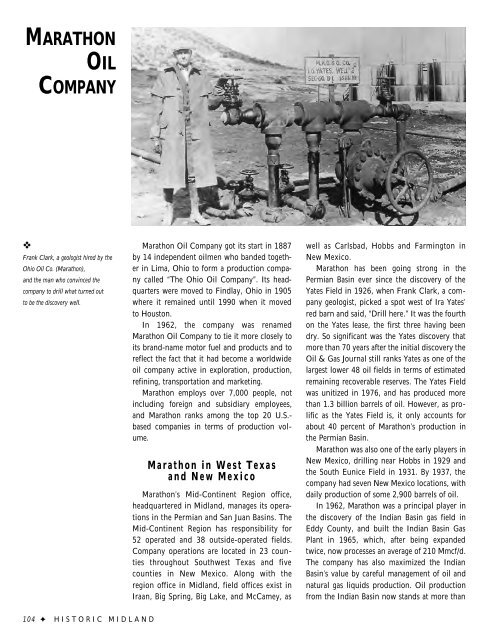Historic Midland
An illustrated history of the Midland County area, paired with the histories of companies, families and organizations that make the region great.
An illustrated history of the Midland County area, paired with the histories of companies, families and organizations that make the region great.
Create successful ePaper yourself
Turn your PDF publications into a flip-book with our unique Google optimized e-Paper software.
MARATHON<br />
OIL<br />
COMPANY<br />
❖<br />
Frank Clark, a geologist hired by the<br />
Ohio Oil Co. (Marathon),<br />
and the man who convinced the<br />
company to drill what turned out<br />
to be the discovery well.<br />
Marathon Oil Company got its start in 1887<br />
by 14 independent oilmen who banded together<br />
in Lima, Ohio to form a production company<br />
called “The Ohio Oil Company”. Its headquarters<br />
were moved to Findlay, Ohio in 1905<br />
where it remained until 1990 when it moved<br />
to Houston.<br />
In 1962, the company was renamed<br />
Marathon Oil Company to tie it more closely to<br />
its brand-name motor fuel and products and to<br />
reflect the fact that it had become a worldwide<br />
oil company active in exploration, production,<br />
refining, transportation and marketing.<br />
Marathon employs over 7,000 people, not<br />
including foreign and subsidiary employees,<br />
and Marathon ranks among the top 20 U.S.-<br />
based companies in terms of production volume.<br />
Marathon in West Texas<br />
and New Mexico<br />
Marathon’s Mid-Continent Region office,<br />
headquartered in <strong>Midland</strong>, manages its operations<br />
in the Permian and San Juan Basins. The<br />
Mid-Continent Region has responsibility for<br />
52 operated and 38 outside-operated fields.<br />
Company operations are located in 23 counties<br />
throughout Southwest Texas and five<br />
counties in New Mexico. Along with the<br />
region office in <strong>Midland</strong>, field offices exist in<br />
Iraan, Big Spring, Big Lake, and McCamey, as<br />
well as Carlsbad, Hobbs and Farmington in<br />
New Mexico.<br />
Marathon has been going strong in the<br />
Permian Basin ever since the discovery of the<br />
Yates Field in 1926, when Frank Clark, a company<br />
geologist, picked a spot west of Ira Yates’<br />
red barn and said, “Drill here.” It was the fourth<br />
on the Yates lease, the first three having been<br />
dry. So significant was the Yates discovery that<br />
more than 70 years after the initial discovery the<br />
Oil & Gas Journal still ranks Yates as one of the<br />
largest lower 48 oil fields in terms of estimated<br />
remaining recoverable reserves. The Yates Field<br />
was unitized in 1976, and has produced more<br />
than 1.3 billion barrels of oil. However, as prolific<br />
as the Yates Field is, it only accounts for<br />
about 40 percent of Marathon’s production in<br />
the Permian Basin.<br />
Marathon was also one of the early players in<br />
New Mexico, drilling near Hobbs in 1929 and<br />
the South Eunice Field in 1931. By 1937, the<br />
company had seven New Mexico locations, with<br />
daily production of some 2,900 barrels of oil.<br />
In 1962, Marathon was a principal player in<br />
the discovery of the Indian Basin gas field in<br />
Eddy County, and built the Indian Basin Gas<br />
Plant in 1965, which, after being expanded<br />
twice, now processes an average of 210 Mmcf/d.<br />
The company has also maximized the Indian<br />
Basin’s value by careful management of oil and<br />
natural gas liquids production. Oil production<br />
from the Indian Basin now stands at more than<br />
104 ✦ HISTORIC MIDLAND
















